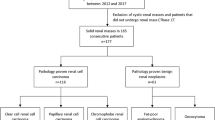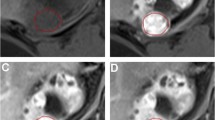Abstract
Objective
To evaluate the diagnostic performance of machine-learning based quantitative texture analysis of CT images to differentiate small (≤ 4 cm) angiomyolipoma without visible fat (AMLwvf) from renal cell carcinoma (RCC).
Methods
This single-institutional retrospective study included 58 patients with pathologically proven small renal mass (17 in AMLwvf and 41 in RCC groups). Texture features were extracted from the largest possible tumorous regions of interest (ROIs) by manual segmentation in preoperative three-phase CT images. Interobserver reliability and the Mann-Whitney U test were applied to select features preliminarily. Then support vector machine with recursive feature elimination (SVM-RFE) and synthetic minority oversampling technique (SMOTE) were adopted to establish discriminative classifiers, and the performance of classifiers was assessed.
Results
Of the 42 extracted features, 16 candidate features showed significant intergroup differences (P < 0.05) and had good interobserver agreement. An optimal feature subset including 11 features was further selected by the SVM-RFE method. The SVM-RFE+SMOTE classifier achieved the best performance in discriminating between small AMLwvf and RCC, with the highest accuracy, sensitivity, specificity and AUC of 93.9 %, 87.8 %, 100 % and 0.955, respectively.
Conclusion
Machine learning analysis of CT texture features can facilitate the accurate differentiation of small AMLwvf from RCC.
Key Points
• Although conventional CT is useful for diagnosis of SRMs, it has limitations.
• Machine-learning based CT texture analysis facilitate differentiation of small AMLwvf from RCC.
• The highest accuracy of SVM-RFE+SMOTE classifier reached 93.9 %.
• Texture analysis combined with machine-learning methods might spare unnecessary surgery for AMLwvf.




Similar content being viewed by others
Abbreviations
- ACC:
-
Accuracy
- AMLwvf:
-
Angiomyolipoma without visible fat
- AUC:
-
Area under the curve
- CMP:
-
Corticomedullary phase
- FOV:
-
Field of view
- GLCM:
-
Grey-level co-occurrence matrix
- ICC:
-
Interobserver agreement
- NP:
-
Nephrographic phase
- PACS:
-
Picture archiving and communication system
- RBF:
-
Radial basis function
- RCC:
-
Renal cell carcinoma
- RFE:
-
Recursive feature elimination
- ROC:
-
Receiver operating characteristic
- ROI:
-
Region of interest
- SMOTE:
-
Synthetic minority oversampling technique
- SRM:
-
Small renal mass
- SVM:
-
Support vector machine
- UP:
-
Unenhanced phase
References
Kutikov A, Fossett LK, Ramchandani P et al (2006) Incidence of benign pathologic findings at partial nephrectomy for solitary renal mass presumed to be renal cell carcinoma on preoperative imaging. Urology 68:737–740
Fujii Y, Komai Y, Saito K et al (2008) Incidence of benign pathologic lesions at partial nephrectomy for presumed RCC renal masses: Japanese dual-center experience with 176 consecutive patients. Urology 72:598–602
Flum AS, Hamoui N, Said MA et al (2016) Update on the Diagnosis and Management of Renal Angiomyolipoma. J Urol 195:834–846
Umbreit EC, Shimko MS, Childs MA et al (2012) Metastatic potential of a renal mass according to original tumour size at presentation. Bju Int 109:190–194 discussion 194
Kim JK, Park SY, Shon JH et al (2004) Angiomyolipoma with minimal fat: differentiation from renal cell carcinoma at biphasic helical CT. Radiology 230:677–684
Zhang YY, Luo S, Liu Y et al (2013) Angiomyolipoma with minimal fat: differentiation from papillary renal cell carcinoma by helical CT. Clin Radiol 68:365–370
Hakim SW, Schieda N, Hodgdon T et al (2016) Angiomyolipoma (AML) without visible fat: Ultrasound, CT and MR imaging features with pathological correlation. Eur Radiol 26:592–600
Yang CW, Shen SH, Chang YH et al (2013) Are there useful CT features to differentiate renal cell carcinoma from lipid-poor renal angiomyolipoma? AJR Am J Roentgenol 201:1017–1028
Xie P, Yang Z, Yuan Z (2016) Lipid-poor renal angiomyolipoma: Differentiation from clear cell renal cell carcinoma using wash-in and washout characteristics on contrast-enhanced computed tomography. Oncol Lett 11:2327–2331
Davnall F, Yip CS, Ljungqvist G et al (2012) Assessment of tumor heterogeneity: an emerging imaging tool for clinical practice? Insights Imaging 3:573–589
Hodgdon T, Mcinnes MD, Schieda N et al (2015) Can Quantitative CT Texture Analysis be Used to Differentiate Fat-poor Renal Angiomyolipoma from Renal Cell Carcinoma on Unenhanced CT Images? Radiology 276:787–796
Yan L, Liu Z, Wang G et al (2015) Angiomyolipoma with minimal fat: differentiation from clear cell renal cell carcinoma and papillary renal cell carcinoma by texture analysis on CT images. Acad Radiol 22:1115–1121
Kumar V, Gu Y, Basu S et al (2012) Radiomics: the process and the challenges. Magn Reson Imaging 30:1234–1248
Parmar C, Grossmann P, Bussink J et al (2015) Machine Learning methods for Quantitative Radiomic Biomarkers. Sci Rep 5:13087
Zhang X, Yan LF, Hu YC et al (2017) Optimizing a machine learning based glioma grading system using multi-parametric MRI histogram and texture features. Oncotarget 8:47816–47830
Nketiah G, Elschot M, Kim E et al (2017) T2-weighted MRI-derived textural features reflect prostate cancer aggressiveness: preliminary results. Eur Radiol 27:3050–3059
Wibmer A, Hricak H, Gondo T et al (2015) Haralick texture analysis of prostate MRI: utility for differentiating non-cancerous prostate from prostate cancer and differentiating prostate cancers with different Gleason scores. Eur Radiol 25:2840–2850
Aerts HJ, Velazquez ER, Leijenaar RT et al (2014) Decoding tumour phenotype by noninvasive imaging using a quantitative radiomics approach. Nat Commun 5:4006
Guyon I, Weston J, Barnhill S et al (2002) Gene selection for cancer classification using support vector machines. Mach Learn 46:389–422
Fehr D, Veeraraghavan H, Wibmer A et al (2015) Automatic classification of prostate cancer Gleason scores from multiparametric magnetic resonance images. Proc Natl Acad Sci 112:E6265–E6273
Wang J, Wu C J, Bao M L et al (2017) Machine learning-based analysis of MR radiomics can help to improve the diagnostic performance of PI-RADS v2 in clinically relevant prostate cancer. Eur Radiol. https:/doi.org/10.1007/s00330-017-4800-5
Zhang X, Xu X, Tian Q, et al (2017) Radiomics assessment of bladder cancer grade using texture features from diffusion-weighted imaging. J Magn Reson Imaging 46: 1281-1288
Chawla NV, Bowyer KW, Hall LO et al (2011) SMOTE: synthetic minority over-sampling technique. J Artif Intell Res 16:321–357
Zhang Y, Oikonomou A, Wong A et al (2017) Radiomics-based Prognosis Analysis for Non-Small Cell Lung Cancer. Sci Rep 7:46349
Yu H, Scalera J, Khalid M et al (2017) Texture analysis as a radiomic marker for differentiating renal tumors. Abdom Radiol (NY). https:/doi.org/10.1007/s00261-017-1144-1
Lee HS, Hong H, Jung DC et al (2017) Differentiation of fat-poor angiomyolipoma from clear cell renal cell carcinoma in contrast-enhanced MDCT images using quantitative feature classification. Med Phys 44:3604–3614
Lin X, Yang F, Zhou L et al (2012) A support vector machine-recursive feature elimination feature selection method based on artificial contrast variables and mutual information. J Chromatogr B Analyt Technol Biomed Life Sci 910:149–155
Jinzaki M, Tanimoto A, Narimatsu Y et al (1997) Angiomyolipoma: imaging findings in lesions with minimal fat. Radiology 205:497–502
Tsukada J, Jinzaki M, Yao M et al (2013) Epithelioid angiomyolipoma of the kidney: radiological imaging. Int J Urol 20:1105–1111
Ishigami K, Pakalniskis MG, Leite LV et al (2015) Characterization of renal cell carcinoma, oncocytoma, and lipid-poor angiomyolipoma by unenhanced, nephrographic, and delayed phase contrast-enhanced computed tomography. Clin Imaging 39:76–84
Silverman SG, Mortele KJ, Tuncali K et al (2007) Hyperattenuating renal masses: etiologies, pathogenesis, and imaging evaluation. Radiographics 27:1131–1143
Liu S, Zheng H, Zhang Y et al (2017) Whole-volume apparent diffusion coefficient-based entropy parameters for assessment of gastric cancer aggressiveness. J Magn Reson Imaging. https:/doi.org/10.1002/jmri.25752
Choi ER, Lee HY, Jeong JY et al (2016) Quantitative image variables reflect the intratumoral pathologic heterogeneity of lung adenocarcinoma. Oncotarget 7:67302–67313
Sidhu HS, Benigno S, Ganeshan B et al (2017) Textural analysis of multiparametric MRI detects transition zone prostate cancer. Eur Radiol 27:2348–2358
Hanahan D, Weinberg RA (2011) Hallmarks of cancer: the next generation. Cell 144:646–674
Johnson PT, Horton KM, Fishman EK (2010) How not to miss or mischaracterize a renal cell carcinoma: protocols, pearls, and pitfalls. AJR Am J Roentgenol 194:W307–W315
Takahashi N, Leng S, Kitajima K et al (2015) Small (< 4 cm) Renal Masses: Differentiation of Angiomyolipoma Without Visible Fat From Renal Cell Carcinoma Using Unenhanced and Contrast-Enhanced CT. AJR Am J Roentgenol 205:1194–1202
Xu X, Liu Y, Zhang X et al (2017) Preoperative prediction of muscular invasiveness of bladder cancer with radiomic features on conventional MRI and its high-order derivative maps. Abdom Radiol (NY) 42:1896–1905
Yip SSF, Parmar C, Blezek D et al (2017) Application of the 3D slicer chest imaging platform segmentation algorithm for large lung nodule delineation. Plos One 12:e0178944
Ng F, Kozarski R, Ganeshan B et al (2013) Assessment of tumor heterogeneity by CT texture analysis: can the largest cross-sectional area be used as an alternative to whole tumor analysis? Eur J Radiol 82:342–348
Funding
The authors state that this work has not received any funding.
Author information
Authors and Affiliations
Corresponding author
Ethics declarations
Guarantor
The scientific guarantor of this publication is Zhichao Feng, M.D.
Conflict of interest
The authors of this manuscript declare a relationship with the following company: GE Healthcare.
Peng Cao is a senior scientist for GE Healthcare (Shanghai, China) and provided the software and necessary training for this study. He has no intention to apply for a patent based on this paper or invent any product, and did not provide any financial support. GE Healthcare did not play any additional role in the study design, data collection and analysis, or preparation of the manuscript. There are no other author disclosures, and the other authors (Zhichao Feng, Pengfei Rong, Qingyu Zhou, Wenwei Zhu, Zhimin Yan, Qianyun Liu and Wei Wang) have no conflicts of interest.
Statistics and biometry
Pengfei Rong and Wei Wang kindly provided statistical advice for this manuscript.
Informed consent
Written informed consent was waived by the Institutional Review Board.
Ethical approval
Institutional Review Board approval was obtained.
Methodology
• retrospective
• diagnostic or prognostic study
• performed at one institution
Rights and permissions
About this article
Cite this article
Feng, Z., Rong, P., Cao, P. et al. Machine learning-based quantitative texture analysis of CT images of small renal masses: Differentiation of angiomyolipoma without visible fat from renal cell carcinoma. Eur Radiol 28, 1625–1633 (2018). https://doi.org/10.1007/s00330-017-5118-z
Received:
Revised:
Accepted:
Published:
Issue Date:
DOI: https://doi.org/10.1007/s00330-017-5118-z




